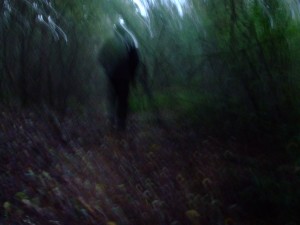Surplus Suburban Swine
It was via the KNJV (Koninklijke Nederlandse Jagersvereniging) Royal Hunting Association of the Netherlands that I got in touch with an Amsterdam hunter who, among other registered hunters, culls the surplus of swine in residential areas. I was eager to learn and find out about the implications of this sudden meat profit and what really meets the eye when it comes to hunting in and near the urban district?
Although not in an urban zone, the hunter did agree to take me on a hunt in and around the Veluwe as there too is a surplus of swine and deer. And so we set out on a nippy October’s day to prey upon deer and after nightfall, swine. The day was unforgettable. We saw many small and big creatures, noticing evidences of their umwelts, their life-worlds: of deer, swine, mushrooms, chewed birch leaves, footprints and cracked remains of devoured beechnuts. While on the hunting post we sat breathlessly still for several hours. Silent. Learning how to see through the thicket of many different greens and feeling the uncanny sensation of being sensed by eyes more conscious, more perceptive than your own. Night fell, but the moon was clouded over, the light too obscured to hunt down a swine. Despite or maybe even thanks to not having shot any wild that day, my first ‘proper’ hunting exercise was a phenomenal experience, literally. The hunter taught me a remarkable lot about experiencing directly one’s surroundings, my own presence in the complex ecology of the woods, the intricate co-existences between species. These hunting skills are unmissable, if only to come to grips with the real-life worlds of your own wild or urban surroundings.

Already since a few years, the conurbanised areas of the Netherlands has seen a drastic increase in young and old wild swine entering residential areas. Wild pigs, boars, swines, call them what you like (we prefer the italian cinghiale) are beginning to call suburban backyards, bicycle sheds and children’s playgrounds their habitat as much as the ‘wild’ forests of netherlandia. It seems that the problem is on the rise in other European cities, notably in Berlin.
Although these bolshy, tusky creatures are becoming evermore adapted to town-life, they are not always a welcome wild to urban emigré. Their growing population means that they are looking for food which is not naturally available to them. When the Veluwe’s supply of acorns and beechnuts have waned the swines migrate to the city zones in search of extra fodder, which usually ends up being lesser foodstuffs — in most cases unsavoury dregs of human rubbish. Feeding-off household garbage is not exactly quality food for swine. Although there are many arguments and counter arguments why the suburbanising swine population should be ‘controlled’ (by means of different urban hunting strategies), one pro argument is that in finding their home in meteropolitan areas the wild swine species, although multiplying like mad, weaken their very swine-ness thus generating a weaker, domesticated (and less toothsome) breed of pig, proably comparable in taste to their pale poor cousins of the bio-industry. Like it or not, hunters have been summoned to take action to cull the wild swine population in and around built-up areas of the Netherlands. On first hearing about the Dutch swine-culling policies, I wondered what happened to the shot swine and how many of these thousands of the unsuspecting sacrificés are überhaupt eaten. As far as I could find out, some are, yet, even though there’s alot of hype about eating wild game most of the Dutch swine are simply too many and too puny. Most of the hunters go to the effort of making hamburger meat, but for the wider populace, the little boars demand too much effort to skin and clean.